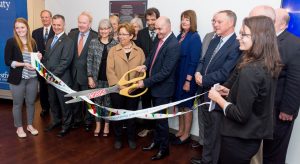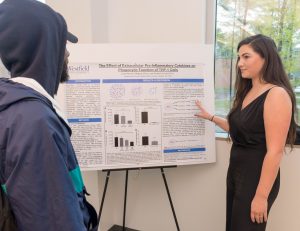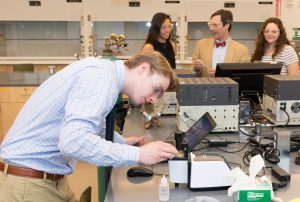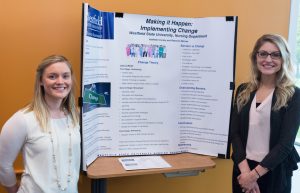
Dignitaries gather around Westfield State University President Dr. Ramon Torrecilha as he cuts the ribbon celebrating the opening of the Dr. Nettie Maria Stevens Science and Innovation Center (Photo by Lynn Boscher)
by Peter Currier, Intern, WSU ’17
WESTFIELD – Westfield State University held the official ribbon cutting ceremony for the newly dedicated Dr. Nettie Maria Stevens Science and Innovation Center on Friday morning.
The ceremony began with opening remarks from Erica Broman, Westfield State’s Vice President of Institutional advancement. She then turned it over to University President, Dr. Ramon Torrecilha.
“This is a gift for the sons and daughters of Massachusetts,” said Torrecilha, “It is a carefully designed building to encourage hands on research and learning experiences.”

WSU student Meghan Kilroe explains her project to a fellow student following the ceremonial opening of the Dr. Nettie Maria Stevens Science and Innovation Center (Photo by Lynn Boscher)
Dr. Stevens, a graduate of Westfield State in the late 19th century when women were not yet accepted in the field of science, pioneered the research of the relationship between chromosomes and sex determination.
“In addition to being the geneticist who discovered the XY chromosomes, she was also described as a dedicated and inspiring leader,” says Dr. Torrecilha.
The 54,000 square foot building is the new headquarters for the University’s nursing, chemical and physical science, biology, and environmental science departments. Most of these departments were previously housed in Wilson Hall, which the new building is attached to.
Dr. Stevens tenure at Westfield State, then known as Westfield Normal School, was brief. She completed what would normally be a four-year program in two years, and graduated on the top of her class. Stevens went on to be a pioneer in the field of genetics in the early 20th century.

Tyler Fassett working in the Chemistry Lab of the new Dr. Nettie Maria Stevens Science and Innovation Center (photo by Lynn Boscher)
“It was Dr. Stevens natural interest in science and the education at Westfield State University that led her to dedicate her life to science” says James Brosnan, a member of the Massachusetts STEM Advisory Council and Chair, “she researched the Human Genome when women were extremely underrepresented in science.”
The Commonwealth has been enacting a statewide strategy to promote STEM education the results of which are that Westfield State has seen a 69 percent growth in male STEM majors, and 109 percent increase in female STEM students over the last 10 years. The national workforce in STEM related fields is only 29 percent female.
Other speakers at the ceremony include State Senator Donald Humason, Commissioner of the Division of Capital Asset Management and Maintenance Carol Gladstone, Founder of MicroTest Laboratories Dr. Steven Richter, and WSU Trustee and former Director of Undergraduate Education at the National Science Foundation Dr. Linda Slakey. Following the speeches, guests were given a tour of the state of the art building.

Kathleen Curley and Reanne Mercier stand by a display about implementing change within the WSU nursing department following the ribbon cutting for the Dr. Nettie Maria Stevens Science and Innovation Center (Photo by Lynn Boscher)
The decision to name the building after Dr. Stevens was rather unorthodox. Typically state law requires that one must make a $1 Million donation in order to have a building named after you, however exceptions can be made in remarkable cases.
Dr. Madeleine Cahill, Professor and Chair of the Communication department at WSU, was one of the original proponents of naming the building after the Westfield State Alum.
“Whenever I mention her to our students, they are surprised and delighted to learn about her” said Cahill in an email to the entire WSU faculty, “They inevitably ask why WSU doesn’t make a bigger fuss about having such a noteworthy alum. I don’t know the answer to that, but I can suggest a solution: name our new science building after her.”
Dr. Diane Prusank, Associate Vice-President of WSU and former Professor of Communications, lobbied the Massachusetts Department of Higher Education to consider Dr. Nettie Maria Stevens as a remarkable case, which they agreed.
“The ramifications for her findings are almost unfathomable,” says Cahill “the implications for history and society are staggering, women around the world were either blamed or credited for the sex of their child.”
Dr. Stevens’ findings proved that women were not responsible for the sex of their children, rather it is whether you have two X-chromosomes for females, or one X and one Y-chromosome for males.
“The fact that it was discovered when it was may have changed the course of history in ways we may never really know,” Cahill says.

